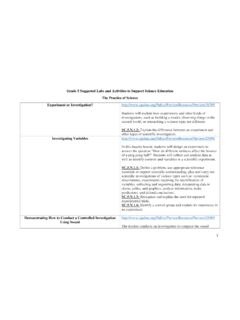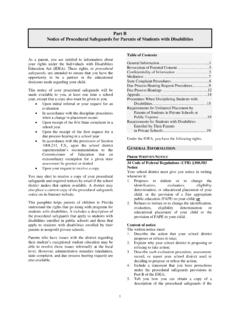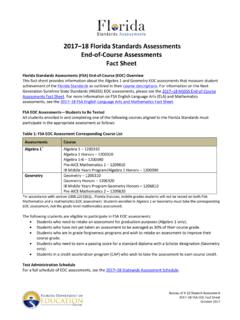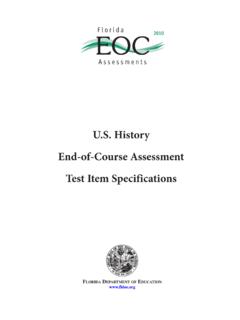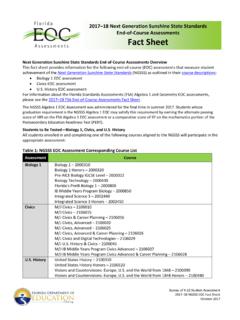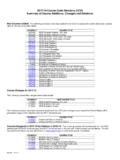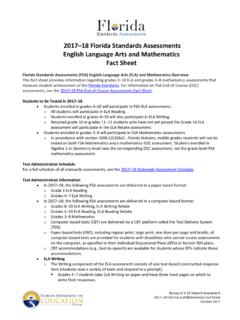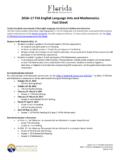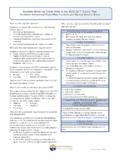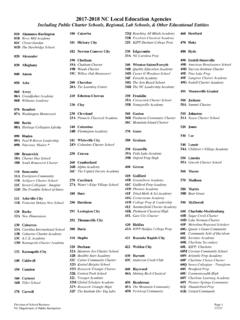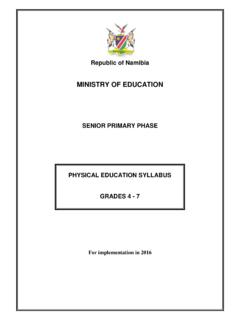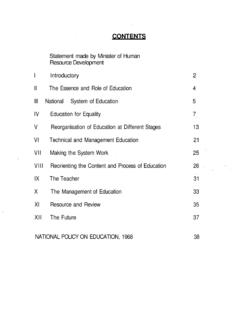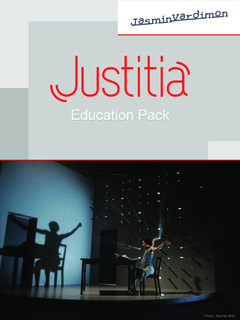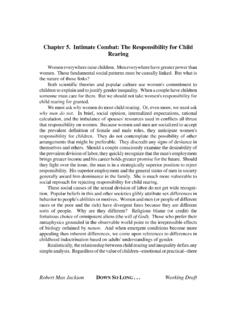Transcription of Grading Policies for Students with Disabilities
1 Paper number: fY 2006-11 April 2006 Technical Assistance Paper 312775 Grading Policies for Students with Disabilities The purpose of this technical assistance paper (TAP) is to provide Florida administrators and teachers with information about identifying and implementing valid and meaningful Grading strategies for Students with Disabilities , primarily those working on Sunshine State Standards. This TAP is intended to introduce recommended practices to assist district personnel in develop-ing and refining Grading Policies . To expand these recommendations, the Bureau of Exceptional Education and Student Services intends to fund the development of an on-line professional de-velopment module addressing Grading Policies for Students with Disabilities following the release of this TAP. Section 1 of this document provides general information on various approaches to using assign-ments and assessments to assign grades; section 2 focuses on the effects of the use of these dif-ferent Grading approaches on Students with Disabilities .
2 Clearly, Grading practices have profound implications for access to the general curriculum, promotion and retention, and postsecondary options for Students with Disabilities and thus need to be addressed by districts, schools, and indi-vidual educational plan (IEP) teams in a thoughtful, collaborative way. For this reason, section 3 outlines recommendations in developing a Grading system that effectively includes Students with Disabilities . Section 1: General Information Applicable to All Students Definition and Evolution of Grading Grading is best understood as a shorthand method of communicating complicated information about student learning and progress (Guskey, 2002; O Connor, 2002). A grade, such as a grade on a report card, is a summary of a teacher s judgment of the adequacy of a student s achieve-ment at a particular point in time (Guskey, 1996). Report card grades should reflect a student s achievement relative to the curriculum standards he or she is working toward.
3 Report card grades should not be used to communicate a student s progress or achievement gain between baseline performance measures and summative outcome measures. Progress monitoring data, which is collected between baseline data and summative data, is best used to communicate student rate of progress through graphic visuals and portfolio records. Grading became part of American education less than a century ago, when compulsory school attendance laws led to soaring enrollment and teachers found it convenient to use percentage grades to quickly summarize information about student achievement. Studies done in the first RefeR Questions to: Heather Diamond ESE Program Development & Services 325 West Gaines Street, Room 601 Tallahassee, FL 32399-0400 850/245-0923 John L. Winn, Commissioner teCHniCALA ssistAnCe PAPeRs (tAPs) are produced periodically by the Bureau of exceptional education and student services to present discussion of current topics.
4 The tAPs may be used for inservice sessions, technical assistance visits, parent organization meetings, or interdisciplinary discussion groups. Topics are identified by state steering committees, district personnel, and individuals, or from program compliance monitoring. BuReAu of exCePtionAL eduCAtion And student seRviCes half of the 20th century exposed early concerns about the validity of grades (Guskey, 1996). These concerns continue to this day, demonstrating that no single Grading system fulfills all the purposes of Grading and is seen as fair for all Students . Purposes and Audiences for Grading Teachers gather Grading information for two distinct reasons: to make instructional decisions (formative assessment) and to communicate a summary of the student s achievement (summative assessment). Formative measures which involve ongoing assessment and Grading feedback for the pur-pose of instructional decision-making is vital to teaching and learning.
5 Teachers must assess the learning of their Students frequently in order to evaluate the effectiveness of instruction and plan for future instruction. This function is separate from the communica-tion function served by report card grades. Summative measures are essential to report card Grading , which primarily addresses the communication purpose of Grading . Educators use report card grades to share informa-tion with parents and Students and to call attention to the needs of struggling Students . Report card grades also have a role in promotion and retention decisions and may be used to identify Students for evaluation for special programs and services. Parents use report card grades to obtain information about the achievement of their child and to determine whether their child needs additional help in school (Guskey, 1996). They also use grades to compare their child to other Students and may use grades to deter-mine whether to give rewards for effort or achievement.
6 Students use grades to evaluate their own performance and set goals for future learn-ing (Guskey, 1996). They also use grades to compare themselves to other Students . High grades may serve as a student s entry ticket for honor rolls, clubs, and universities and may be motivating for some Students . However, low grades appear neither to motivate Students to greater effort nor lead to improved performance; instead they may actually decrease engagement, motivation, and performance (Guskey, 1996; Hargis, 2003). Given that grades are a significant, and sometimes sole, method of communication about stu-dent achievement, it is vital that they reflect valid and meaningful information for the teacher, student, and parent. The rest of this section focuses on the relationship between various Grading approaches and the validity and meaningfulness of report card grades. The differences in Grading approaches among teachers are reflected in the factors they choose to consider in the calculation of grades and to what they choose to compare the student s work.
7 These elements are discussed separately below; however, they are closely interrelated and work in combination to form a teacher s overall Grading approach. Approaches to Grading : What Does the Grade Reflect? Some teachers determine grades based solely on the student s academic performance; other teachers include factors not directly related to the demonstration of academic learning such as 2 effort, participation, homework, spelling, work habits, or behavior. McMillan (2001) found that teachers grade mostly on achievement, but that they do consider other factors, such as homework and perceived effort. Research shows that the most effective practice is to determine the academ-ic grade based on academic performance only, for several reasons. To be meaningful, grades must focus on achievement. Grades that include effort or par-ticipation do not give parents or Students a clear picture of the student s academic learn-ing.
8 Using academic grades to punish poor behavior or effort is not effective and does not lead to improvement (Guskey, 1996; Hargis, 2003). All Grading approaches include an element of subjectivity. This inherent subjectivity is legitimate since it admits the teacher s professional judgment into the Grading equation. However, bias, which is defined as letting nonacademic aspects such as behavior or neat-ness affect academic grades, negates the meaningfulness and validity of grades (Guskey, 1996; Hargis, 2003). For example, teachers tend to equate poor behaviors with lower academic achievement (Bennett, Gottesman, Rock, & Cerullo, 1993). This may lead to a Grading bias against boys, whose behavior is generally viewed less favorably by teachers than is girls behavior. It may also lead to a bias against Students with Disabilities , whose behavior is also more frequently viewed negatively by teachers. Similarly, allowing a bias against poor handwriting (Sweedler-Brown, 1992) to influence a student s academic grade makes the grade itself less valid as a measure of the student s mastery of the con-tent of instruction.
9 Giving additional, separate grades for other elements such as effort, participation, and behav-ior keeps the focus of the academic grade on learning, while giving parents and Students specif-ic information about behavior, effort, and participation (Stiggins, Arter, Chappius, & Chappius, 2004; Hills, 1991). Approaches to Grading : What Is Compared for the Grade? Grades reflect either a comparison of the student s performance to the performance of other Students , a comparison of the student s performance to his or her own previous performance, or a comparison to established learning criteria. Comparison to the performance of other Students -This practice is commonly known as Grading on the curve. Research shows that it is ineffective. It does not reflect or communicate meaningful information about learning, but only about relative standing. It does not provide feedback to learners on what they need to do to improve their performance and thus their grade.
10 It only tells where Students stand in relation to classmates, creating an artificial standard that would change every year with a new group of Students . It may be next to impossible for Students who begin as low achievers to improve their grade, even if they have made good progress in learning. Similarly, it does not support improvements in instruction because Grading on the curve does not give teachers the incentive of seeing their effective instruction lead to increased levels of success for all their Students . Comparison to the student s previous performance- Grades based on the student s individual progress take ability into account by reflecting the student s movement from a baseline performance measure. Progress monitoring is an important part of instruction for frequent measurement of learning gains. This practice can help Students and parents determine whether the student s learning in particular areas is progressing in the right direction and should be included as part of the overall reporting system.
